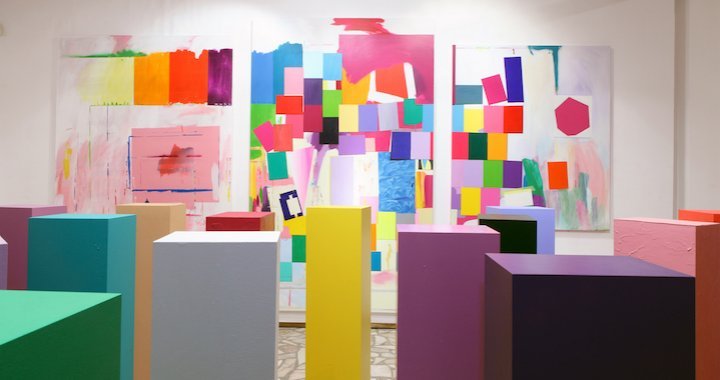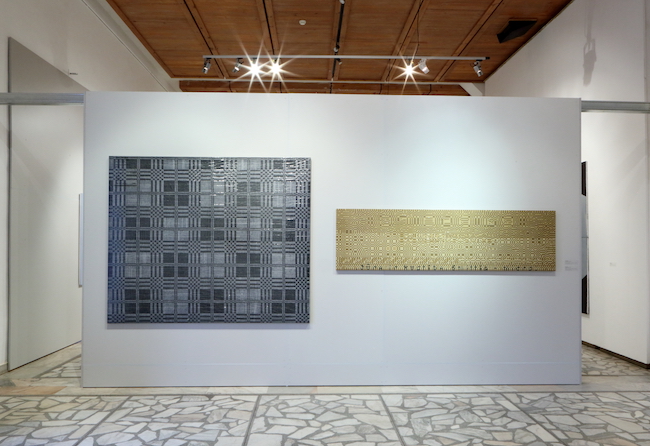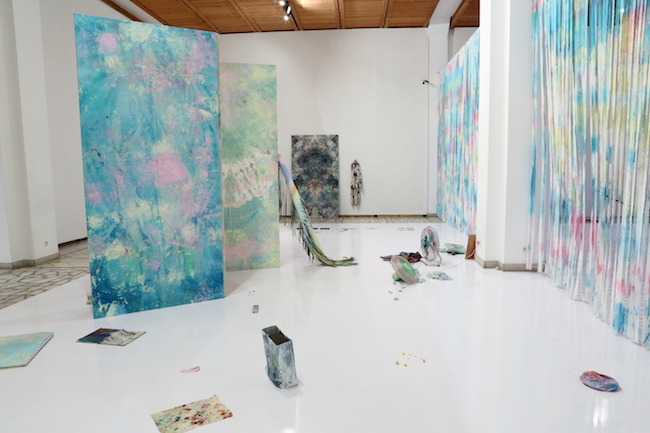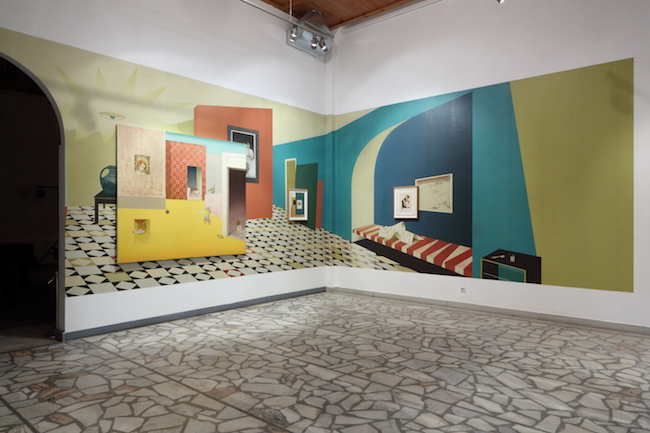
Wonderings in the Vilnius Painting Triennial
Līna Birzaka-Priekule
26/12/2016
Translated by Laima Ruduša
If you get on a bus and head to Lithuania, you can still make it to the 16th International Vilnius Painting Triennial exposition, which is on until the 31st of December. This year’s exhibition title is Nomadic Images, which presents an exchange of international art experience and showcases topicalities from Lithuania, Estonia, Latvia, Denmark, Poland, Czech Republic, Sweden, Norway, Romania and other countries. This year’s triennial’s substantive idea is based on the absorption of new territories, without emphasizing any particular priorities, just allowing one to compare, evaluate, and enjoy it all – without competition or an air of challenge. Each can match the array on an equal footing. The nomadic space is understood as a decentralized expanse and spatial subjugation, an arena of unplanned events, coincidences, spontaneity and cruelty. [1] The exhibition organizers themselves claim that a conceptual approach to the subject matter of the triennial’s works makes it possible to avoid a horizontal view of painting in general and gives it an intellectual dynamic.

Andris Vītoliņš. Jaunā pieredze (New experience), 2014. Photo credit: vilniustriennial.lt

Kristaps Ģelzis. Lupatu deķis (Rag Rug). 2014. Inčupe. 2015. Photo credit: vilniustriennial.lt
The triennial is made up of two parts – each located in a different Lithuanian city. Contemporary Lithuanian painting is on display in Kaunas, but this time I will focus on the international exhibit at the Vilnius Museum of Decorative Arts and Design exhibiting the works of Latvian artists Andris Vītoliņš and Kristaps Ģelzis (Vītoliņš’ New Experience and Ģelzis’ Inčupe and Rag Rug). The exhibition curators say that the exhibition has been arranged in the form of a labyrinth, but it rather seems to resemble cages in which the works are assembled more mechanically according to their formal and stylistic similarities. Although the curators’ arrangement seems too didactic, the increasing delight in the artworks from one cage to the next pleases me more and more. The curators apparently did not want to examine all the possible trends of today's painting, but the arrangement of the exhibition illustrates that there has been an attempt to place works in a particular contextual order. In this way we can see expressive Op-art influences, realism, comic aesthetic, and expressive colour in the painting work, however the most interesting works turned out to be the ones that stepped outside (also in the physical sense) of traditional forms of painting and in which the artists combine painting with their own techniques and research. Gilles Deleuze in his book on Francis Bacon, chapter “The Painting before Painting”, writes: “It is a mistake to think that the painter works on a white surface... The painter has many things in his head, or around him, in his studio. Now everything he has in his head or around him is already in the canvas, more or less virtually, more or less actually, before he begins his work. They are all present in the canvas as so many images, actual or virtual, so that the painter does not have to cover a blank surface but rather would have to empty it out, clear it, clean it.” [2] Here I will turn to the works that, in my opinion step out of their frames and seek and attract attention with their non-traditional approach to the painting process.

Broņus Gražis. Decoration, 2016. Photo credit: vilniustriennial.lt

Merike Estna. Blue Lagoon, 2014. Photo credit: vilniustriennial.lt
Merike Estna’s large-scale installation Blue Lagoon somewhat makes up the centre of the exhibition. And this work is an excellent basis to begin talking about painting outside of its formalities, and also as a turning point in my wanderings through the exhibition, because, just walking behind Merike's tie-dyed curtains, a completely different perspective opened up on the whole exhibition. Merike’s work probes the question of what is painting today and what kind if surfaces it can be expressed upon. Blue Lagoon is created as an artist’s studio, where colour has exploded onto all the installation objects. Wind fans, piles upon piles of fabrics, aprons, propped up paintings, messed up papers. The work makes you think about the “interior” of painting, as this space, it seems, is a space after a process, where all the energies of creation have splashed out into pastel coloured slots.

Jonas Gasiūnas. Alpine Shooter Passed by, 2015. Photo credit: vilniustriennial.lt

Žygimantas Augustinas. Anthropometric Portrait of King Sigismund Augustas (by Ž. Augustinas), 2015. Sigismund August (in). Royal Palace, Reincarnation, 2016. Photo credit: vilniustriennial.lt
Another researcher is Žygimantas Augustinas [3], who has reincarnated his almost-namesake Žygimantas Augustas (in English known as Sigismund II Augustus), the Duke of Lithuania and King of Poland, in a personality portrait format. Why are they almost namesakes? Because their names are only separated by two letters in the surname –in, thus the title of the work is The Case of IN. Žygimantas, himself says that his portraits are a result of research, which addresses the volatile mind generated image transformation in materials and existing images, by analysing how portraits of people that can not be seen or photographed are created. [4] The artist plays out narratives in his works; to what extent both namesakes’ lives may be related. 168/5000 Based on the royal portraits of Lucas Cranach the youngest and realistically embodying himself in his image, he ironically remarks on the distance of time in visually accurate depictions of historical persons. A Google Maps photo from the old King’s renovated bedroom joins the series of paintings. The artist’s physical presence in the painting turns into his objective portrait – reorganized from black dots, which have been left over from the artist, after his merging with the great Žygimantas Augustas.

Mykola Bilous. Optimism. 2015. Photo credit: vilniustriennial.lt

Mircea Suciu. Iron Curtain, 2015. Still life, 2015. Photo credit: vilniustriennial.lt
Romanian artist Mircea Suciu’s three large-scale works are surprising. Each of them portrays three seated men wrapped in fabric. The used postures and impressive size of the paintings suggest Raphael and Velazquez's portrayal of the pope, but the envelopment and concealment of identity evokes Christo's wrapped Reichstag and other objects. The works are made on canvas using mono-printing techniques and then painted with oil and acrylic. Mircea Suciu, says himself that he doesn’t think of himself as a painter, but more as a significant image creator. [5] He uses photography and his painting process, called re-painting, photography restoration. Mircea Suciu’s wrapped up human body’s covered in silver, black shiny and army camouflage fabric, whose impressive gatherings allow the paintings a very strong visual language in which to talk about the relationship between power and the individual in the context of contemporary politics.

Jens Fänge. Work. Photo credit: vilniustriennial.lt

JJens Fänge. Palm, 2016. Photo credit: vilniustriennial.lt
In concluding my impressions, I would like to mention the Swedish artist Jens Fänge’s work – a self-generated painting exhibition space on the museum wall. It is a strangely unreal room where his own paintings are arranged on the wall. This work, in my opinion, embodies the exhibition’s chosen theme - the labyrinth. A lot of visual inputs and outputs flicker in front of your eyes, which are reminiscent of De Chirico’s metaphysical space. It is a colourful and confusing maze, where you want to find a common denominator, but, no matter how long you stand there, you become ever more puzzled.
In response to an interview question, what value he sees in the opportunity to participate in the Vilnius Triennial and how it discloses the current situation in painting, Jens Fänge responded quite simply: “I believe painting is important. My paintings get to travel and meet paintings from other countries. That’s good.” [6]
And although the location selection for this exhibition is really not a very good match for the contemporary content (and besides, concerts are still held next door, which require the exhibition visitors to walk on tiptoe), there are still at least 10 works, for which it is definitely worth going to Vilnius.

Jonas Jurcikas. Space Traveller, 2015. Photo credit: vilniustriennial.lt
[1] www.vilniustriennial.lt
[2] Deleuze, Gilles. Francis Bacon. The Logic of Sensation. Continuum, London, New York. The English translation 2003. 86 p.
[3] Žygimantas Augustinas received an award in the 12th Vilnius Triennial as the best debut
[4] www.augustinas.lt
[5] Interview with Mircea Suciu on the Triennale website: www.vilniustriennial.lt
[6] Interview with Jens Fänge on the Triennale website: www.vilniustriennial.lt